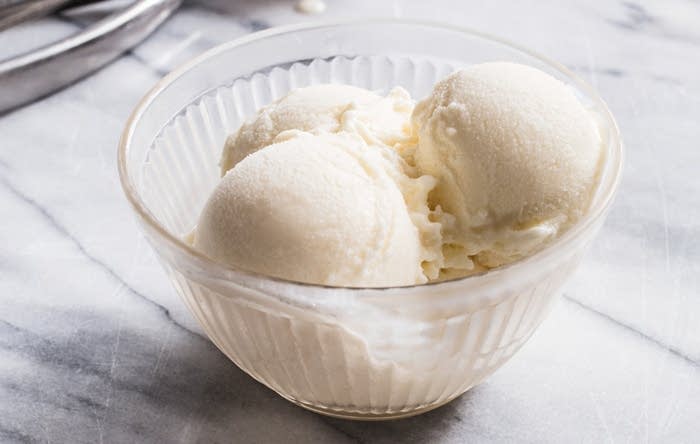
Making ice cream and frozen yogurt requires skill, so much so that Penn State offers a course on the subject. Molly Birnbaum, executive editor of Cook's Science for America's Test Kitchen, attended, and shares what she learned with Sally Swift.
[More from Birnbaum]
Sally Swift: It is the time of year for homemade ice cream and I bet you have some ideas for us.
 Molly Birnbaum
Molly Birnbaum
Molly Birnbaum: I sure do. We have been very busy in the world of ice cream over at Cook's Science in America's Test Kitchen of late. We actually went to something called the Penn State Ice Cream Short Course this past winter, where we learned a ton of things.
SS: And who was there?
MB: “Who wasn’t there?” is the question. I went with my colleague Dan Souza, and there were 120 other people in this seven-day-long course, which is legendary. It's been going for more than a hundred years straight. It was the who's who of ice cream, and it has been for a long time. Some of the big greats from the largest ice cream companies have come through this course. Jeni Britton Bauer, who founded Jeni's Splendid Ice Creams out of Ohio, came to this course in 2000, and that helped her launched her own ice cream business.
SS: I would imagine Ben and Jerry attend?
MB: One of the two, Ben or Jerry, has definitely attended this ice cream short course.
SS: What did you figure out about ice cream there?
MB: This short course was to learn about the science of mass-market ice cream, which I quickly learned is very different from the science of homemade ice cream. When we were there, we were actually working on a recipe for frozen yogurt at America's Test Kitchen, so we had a lot of questions. And what we learned is that ice cream is incredibly complicated, not just for home cooks but for food scientists. It filled seven straight days of classes just about ice cream. There's a lot there.
SS: Wow. I suppose it's a very fragile thing.
MB: Ice cream is incredibly fragile. There are so many places to go wrong. What you're doing is combining relatively simple ingredients, but you are trying to make it incredibly smooth and creamy and so it stays that way. If it gets too warm, if it gets too cold, if it goes up and down in temperature, if you don't have enough fat, things can get icy. And that's the worst.
SS: What did you figure out about your frozen yogurt experiment?
MB: Our goal for this frozen yogurt was to make a classic, tangy, plain frozen yogurt recipe. What we found when we were making it is that when we used Greek yogurt from the supermarket, which is a pretty dense, thick, tangy, delicious yogurt, we were getting frozen yogurt at the end that was a little bit chalky and a little bit dusty-feeling, which wasn't that great. But when we took plain, whole-milk yogurt and we drained it of whey, which is the liquid that comes in a yogurt, we got a much better texture. So we were very curious about what was going on there.
SS: That makes no sense, because Greek yogurt is essentially drained yogurt. Did you figure it out?
MB: We did. We asked around a lot when we were at the Penn State Ice Cream Short Course, and we ended up speaking with an ice cream expert named John Hopkinson of DuPont. What he told us was that the combination of low pH and high protein, and Greek yogurt has a lot more protein than regular whole milk yogurt, can produce that dusty, chalky quality that we noticed. He also told us that commercially-produced Greek yogurt is strained by centrifuge, so they get rid of that whey by using a centrifuge, and that process can damage the proteins and increase the likelihood of a chalky defect.
SS: Wow, that is delicate.
MB: Right. There are so many things that can go wrong.
SS: It sounds like it is really about controlling the water in a way.
MB: Good ice cream is about controlling the water, because the water is what creates the ice crystals, and bad ice cream is icy ice cream.
SS: In your recipe, you are buying whole milk yogurt, you’re draining it, and then you're using that as the base you freeze in an ice cream maker.
MB: Yes. We also use a little bit of unflavored gelatin to help trap the water in there, so it doesn't become icy and ice crystal-y. Also some sugar, Lyle's Golden Syrup, which is an invert sugar, which depresses the freezing point of the mix a little bit and helps it stay smoother and creamier when you freeze it, and a tiny bit of salt. That's all.
SS: And then my big question is, does it have to be full fat, or can you use low-fat yogurt for frozen yogurt?
MB: For this particular recipe, you definitely need the full fat. It makes a much creamier, more delicious end product.
SS: How did I know you were going to say that?
MB: Yeah, sorry.
Before you go...
Each week, The Splendid Table brings you stories that expand your world view, inspire you to try something new, and show how food connects us all. We rely on your generous support. For as little as $5 a month, you can have a lasting impact on The Splendid Table. And, when you donate, you’ll join a community of like-minded individuals who love good food, good conversation, and kitchen companionship. Show your love for The Splendid Table with a gift today.
Thank you for your support.
Donate today for as little as $5.00 a month. Your gift only takes a few minutes and has a lasting impact on The Splendid Table and you'll be welcomed into The Splendid Table Co-op.





